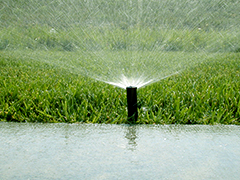Excess Water Use and Non-Residential Accounts#

Non-residential (commercial and irrigation) water taps are subject to an excess water use surcharge if they exceed their annual water allotment. These include water taps that serve businesses, as well as irrigation for multi-family complexes and common spaces in HOAs. The 2025 surcharge amount is $15.59 per 1,000 gallons over the allotment.
-
Participate in the Xeriscape Incentive Program: Accounts may be eligible to receive up to $15,000 in rebates when pursuing a water-saving landscape renovation project.
-
Sign up for MyWater: Monitor your hourly water use and receive free leak alerts via email with Utilities' online tool (formerly known as WaterSmart).
– MyWater Guide: How to find your allotment and up-to-date water usage.
-
Reduce water use through efficiency and conservation projects: Apply for rebates and receive an efficiency check or indoor water audit.
- Increase your account’s water allotment: The 2025 rate is approximately $0.20 per gallon. Click here to learn more.
-
Allotment: The volume of water a tap can use in a 12-month period (Dec. 1 – Nov. 30) before incurring an excess water use surcharge. The allotment volume is determined by the Water Supply Requirement (WSR) fee paid at the time of development plus any increases to the allotment paid for after development. A customer may increase an allotment by providing City water certificates and credits or by paying a WSR fee. Allotments only apply to non-residential taps.
- Excess water use surcharge: A volumetric charge based on all water used through the remainder of a 12-month billing period once a customer has exceeded their annual allotment. The 12-month accrual period is Dec. 1 – Nov. 30. A surcharge is applied in addition to the regular utility rates. The 2025 surcharge rate is $15.59 per 1,000 gallons over the allotment.
-
Water Supply Requirement (WSR) fee: A development fee collected to pay for the water necessary to serve either a new development or redeveloped non-residential properties that require a larger tap. The fees can vary based on a development’s characteristics (e.g., square footage, business type, number of bedrooms). Developers pay the fees during the building permit process. WSR fees do not apply to redevelopment unless the property needs more water than is currently allotted.
WSR fees:
- Ensure secure water sources and protect the watershed
- Provide a financial mechanism to ensure current and future assets are adequate to meet community water supply and service needs
- Balance current needs and supply and future potential needs and acquisitions
In general, the fee varies such that lower-water-use developments pay less, while higher-water-use developments pay more. Non-residential and irrigation accounts’ WSRs are translated into annual water allotments. Surcharges are applied when the annual water allotment is exceeded.
-
Non-residential: All commercial, industrial, public entity, group housing, nursing homes, fraternities, hotels, motels, commonly-owned areas, club houses, and pools, including HOA common spaces and irrigation accounts.
-
How are allotments determined?
Allotments are considered during development or redevelopment. They are based on the account's estimated use and tap size.
-
What is the purpose of an allotment?
Depending on the type of account, some customers use more water than others. Water allotments are based on the Water Supply Requirements (WSR) provided to Utilities to meet the customer’s needs. Funds collected through surcharges help offset any water use that exceeds the allotment and allows Utilities to acquire additional water supplies.
-
What is the purpose of the surcharge?
Unlike regular utility rates, which cover the cost of operation and maintenance of the distribution system, revenue from surcharges go toward acquiring, developing and improving Utilities’ water resources to lessen the impact of customers exceeding their planned water demands/allotments.
-
How do I know if am going to receive a surcharge?
Monitoring use is essential to ensuring an account does not exceed its allotment. Sign up for MyWater, our complimentary monitoring service.
-
If I exceed my allotment, when will I start to see the surcharge on my bill?
The surcharge will appear on the monthly bill when the allotment was first exceeded. It will be applied for the remainder of the calendar year as well. For example, if a customer exceeds their allotment in the middle of July, the surcharge will appear for the first time on the July bill and will appear on all subsequent bills for the remainder of the year. The 2025 surcharge rate is $15.59 for every 1,000 gallons.
-
How do I determine my allotment size?
For more information, call Utilities at 970‑416‑4268 or visit MyWater.
-
How do I determine if I need to increase my allotment?
Utilities can help you determine if an increase to an assigned allotment is needed or if you can improve water efficiency to use less than the account's assigned allotment. Contact Utilities Water Conservation for more information at 970‑416‑4371 or email WaterConservationStaff@fcgov.com.
-
How can I increase my allotment?
First, contact Utilities Water Conservation at 970‑416‑4371 to determine if it is necessary to increase the allotment. If it is, customers can pay to increase the allotment at any time.
-
Who can I contact with questions?
Reach out to our Utilities Business Resource Team at UtilitiesBizResourceTeam@fcgov.com or 970‑416‑4371.
Did You Know?
Completing a building tune-up (retro-commissioning) ensures existing systems perform as designed.
Water that goes down storm drains is not treated before it goes back to the Poudre. You can help protect our waterways for future generations.
To keep high-efficiency toilets and sinks performing well, remember to only flush the three Ps and throw FOG in the trash.